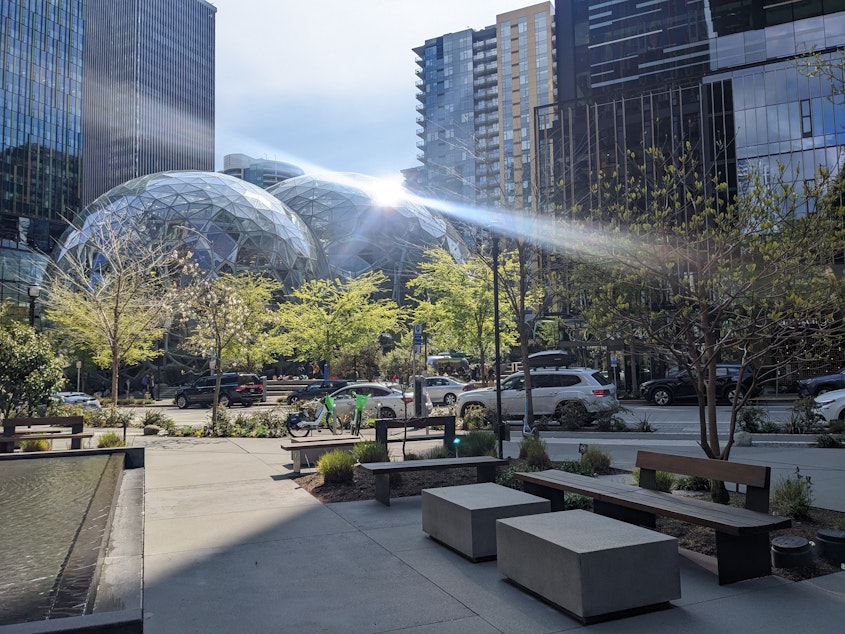Highest level of Seattle office workers since the Before Times: Today So Far

- Half of Seattle's downtown office employees have returned to their desks ... what does that actually mean?
- We need to get fish back into the Skagit River.
- These starfish are coming back.
This post originally appeared in KUOW's Today So Far newsletter for June 15, 2023.
Half of Seattle's downtown office employees have returned to their desks. That's according to new numbers from the Downtown Seattle Association, which says that downtown office foot traffic is the best it has been since before the pandemic.
Here's the nuance in the numbers. They're comparing May 2023 with May 2019, before the pandemic shut things down, as the standard of measurement. Also, the in-office numbers only account for Tuesday through Thursday, which are the most common days that folks are coming into the office. People still prefer to stick around home on Mondays and Fridays.
The increased foot traffic has come as good news to downtown businesses, and bad news for anybody on the area's roads. The sudden influx of office commuters has been noticed on the routes into Seattle.
There are some other takeaways from the DSA's numbers. Check out the full story here.
Seattle City Light operates hydroelectric dams throughout the region, including three dams on the Skagit River. If you turn on your lights in Seattle, this is where about half of that energy comes from. We value those lights, and also Netflix, PS5s, and plugging in electric cars. But this energy has come at the cost of salmon runs.
City Light is now engaged in a project expected to take about two decades — create a path for salmon to get around three dams on the Skagit River. This would reintroduce salmon to habitats they have been cut off from for generations.The project is bigger than City Light, too, with partners ranging from local tribes to federal agencies. It's early in the process and there are still hurdles to jump before getting started. Read the full story here.
Folks have their eyes on another species out on the coast. Starfish are showing signs of a comeback after years of suffering from a wasting disease. Ochre star populations are on the upswing across the West Coast, including in Puget Sound.
“The population has been rebounding,” Olympic National Park biologist Steve Fradkin told KUOW. “It's still not to where it was, but we're not losing a lot of organisms.”
That doesn't mean things have entirely corrected. There are about 20 species that this disease has affected, and they remain under threat. Scientists also do not have an answer for where the wasting disease even came from.
“As a scientist, it's troubling to not be able to have a definitive answer for what is causing it,” Fradkin said.
Check out the full story here.
AS SEEN ON KUOW

People play games and enjoy music Tuesday, June 13, 2023, as Seattle City Hall Park welcomed the public back, after a two year closure. (Natalie Akane Newcomb / KUOW)
DID YOU KNOW?
The Carlile Room in downtown Seattle has a hip, swanky, yet laid back cocktail vibe, right across the street from the Paramount Theatre. It's the kind of place where you can order champagne with french fries. There's a few images of Bob Dylan around the bar, but the Carlile Room draws its name from another folk hero — Brandi Carlile.
Yep. This factoid comes across my path every now and then. When The Carlile Room opened in 2015, it was Tom Douglas' 19th restaurant. The idea for the place began when the chef and restaurateur purchased a black-and-white Bob Dylan painting, which led to a cocktail spot with music vibes. Douglas happens to be a fan of Brandi Carlile, so he named this spot after her. In fact, one of Carlile's acoustic guitars hangs over the host stand.
ALSO ON OUR MINDS

Louisiana's Fort Polk became the latest U.S. Army installation to shed its Confederate namesake on Tuesday when it was officially renamed Fort Johnson after a Black World War I hero. The base now honors Sgt. William Henry Johnson, whose actions on the front lines in France earned him a posthumous Medal of Honor nearly a century later.

